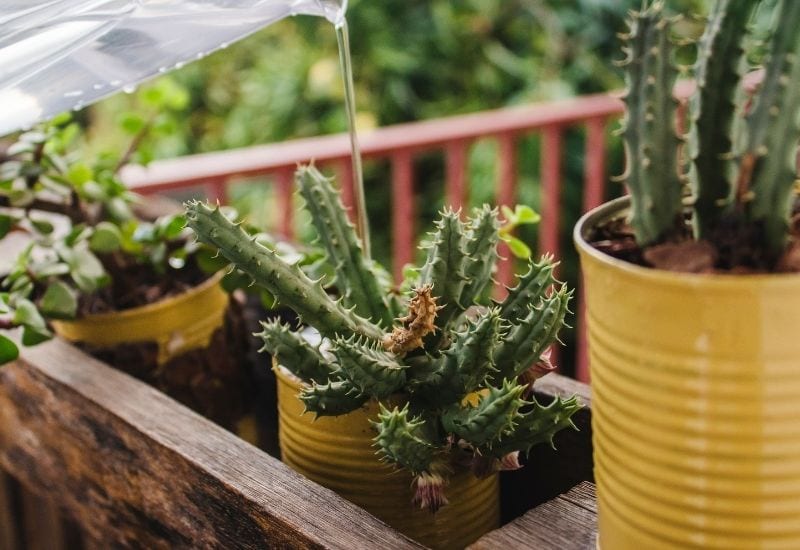
Let’s just picture it, set against a scorching Sun, in the middle of a desert and with two branches that look like arms punching the hot air in joy, maybe after a soccer match… What am I talking about? A cactus of course.
When we think about these plants, images of heat, sombreros and even drought come to mind, certainly not humidity, clouds and wet places, do they?
Even if cacti can go for long times with now water, however they do need some every now and then, but the question is, how often should you need to water cactus?
You should water a cactus only when the soil has dried up completely and never before that. How often this will be depends on the climate, season and other factors, but, on average, it is every seven to ten days in most cases when the plant is growing and every ten to fourteen days when it is dormant.
This is the average, but if you really love your cactus, you should read on, because there are many things you need to know to make sure your cactus thrives and stays healthy.
How do you know if your cactus needs water?
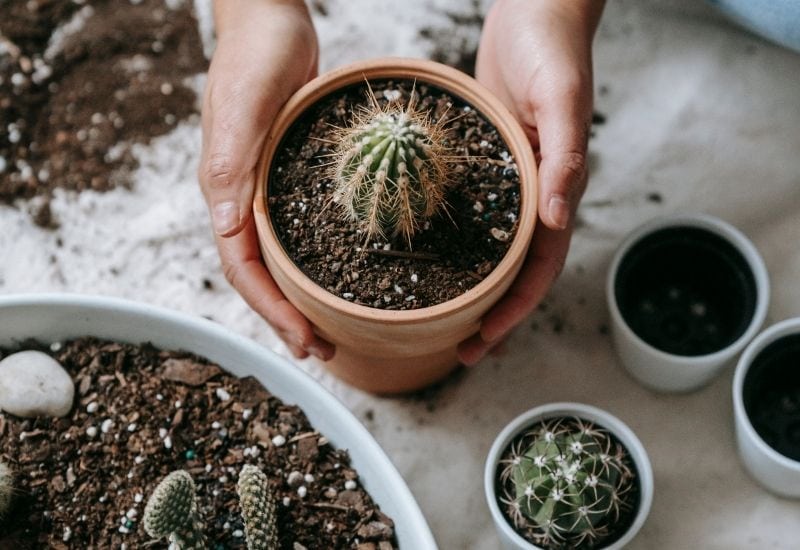
You don’t know how to “read” the signs that your cactus gives you? Don’t worry, there’s a very simple general rule that you can follow: Only water your cactus once the soil has dried completely.
While with other plants you may want to water once the first inch or so of soil is dry (in many cases, but not all), with cacti you must wait till their roots are in fully dry soil.
This is for many reasons, to start with, because they need little water, but also because if you bring the humidity in the soil close to zero, you will prevent fungus and bacterial growth, which, especially with succulents, can spell disaster.
How dry should I allow the soil to get?
Sometimes though, very dry may become “too much”. So, when is dry “too dry” for cacti? There’s a simple rule gardeners use: Allow the soil to dry but not to dry so much that it cracks and it pulls away from your cactus pot.
So, always check around the edges of your pot and see if you notice any gap between the pot itself and the soil, if so, it means you have waited a bit too long and it is time to water your beloved plant.
How often should I expect to water my cactus?
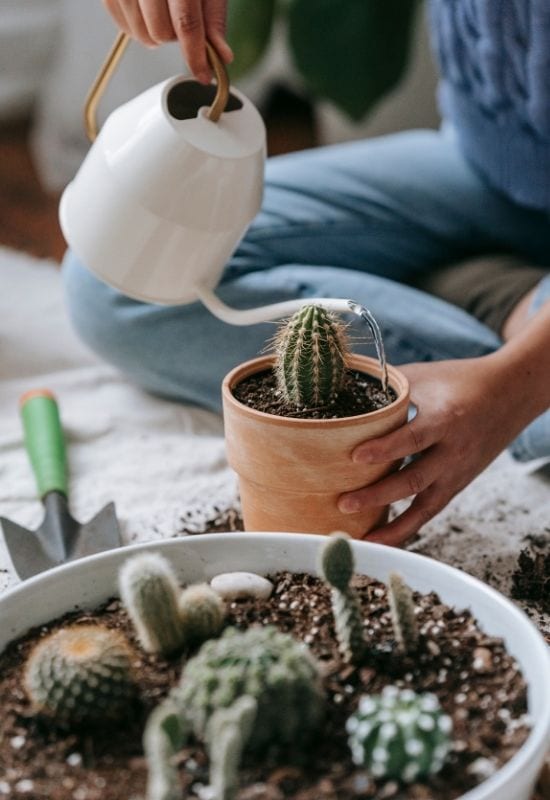
“Ok,” you may say, “but on average, how often should I check the soil?” You are right to ask, because of course, you may not have the time to check daily, nor do you need to. Most people would check weekly, and then wait if the soil is not fully dry.
You should water your cactus every 7 to 10 days during non-winter months when temperatures are above 40 degrees. During the winter time (when temperatures are below 40 degrees) you should reduce watering to at least once every 10 to 15 days because it is dormant during this time.
What things affect how much I water my Cactus?
There aware a few factors that may affect how fast the soil gets dry:
The Type Of Soil
Cacti like light soil and especially well drained soil. If you use cactus potting compost, for example, you will more or less fall within the average, but in case you see the soil does not dry up fast enough on a regular basis, my advice is to repot the cactus or add drainage, like sand and gravel or little pebbles.
The Temperature And Climate
Naturally, if you live in hot and dry places, the soil will dry up faster than if you live in cold and wet places.
Thus, if you live in Mexico you may well find yourself watering your cactus more often than if you live in New England.
The Microclimate And / Or Room Climate
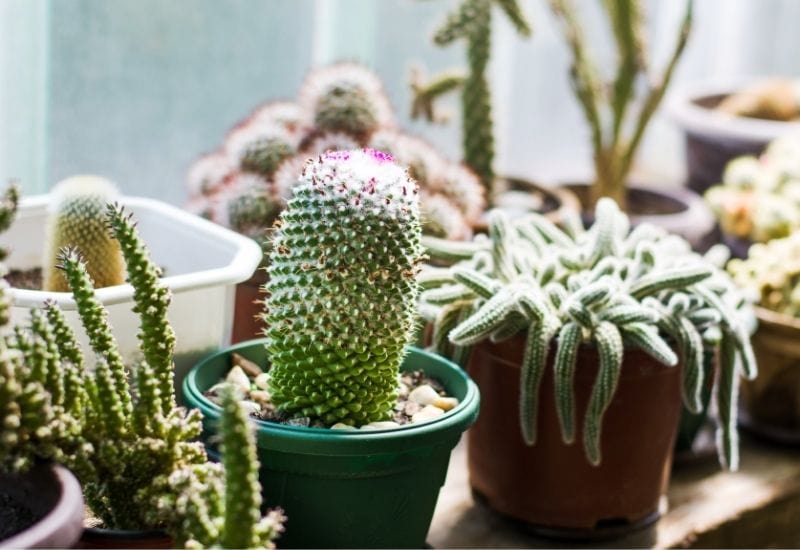
Much will depend on whether you grow it indoors or outdoor. If indoor, the humidity, temperature and exposition of the room will affect the watering your cactus needs.
The same applies to whether you have heaters on, humidifiers or dehumidifiers etc…
Wind
Even the wind can affect how often you need to water cacti; In fact, it does dry up the soil, so, windy places may require more watering than places with little wind.
But wait a second… I said, “During the growing season…” How about when the cactus is not growing?
Watering Cactus during the dormant phase
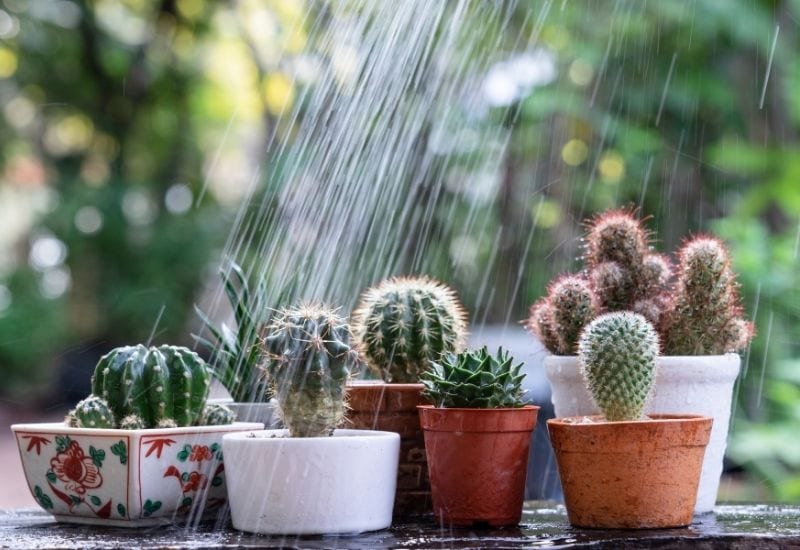
Most cacti go into dormancy, which is a life phase of many plants when they slow down their metabolism and stop growing. In this phase (which is usually in winter, but not necessarily), you will need at least to reduce watering, and sometimes even stop it for fairly long periods.
On the whole, remember that in winter or, in any case, during the dormant season, less is better, also because cacti are more vulnerable to infections and pests during this phase.
How can you check that the soil is dry?
“But hold on,” you may say, “I don’t have X-rays, so how can I check that the soil is fully dry?” My favorite method is to use a chopstick. Just stick it into the ground and leave it in the pot.
When you go to check if your cactus needs watering, take it out and “read” it exactly as you do with the water oil gauge of your car…
Then put it back in…
You can even use a thin bamboo stick or a skewer pick if you want…
Should you water cacti when you plant them or repot them?
Yes, it but not immediately! It’s recommended to wait a week to water your cacti after you repot it.
This seems counterintuitive as the first thing we do with all plants after we have found them a new home is to give them water…
True, but cacti are a bit idiosyncratic… They like to get to know the new soil with their feet still dry before being watered.
How should you water your cactus?
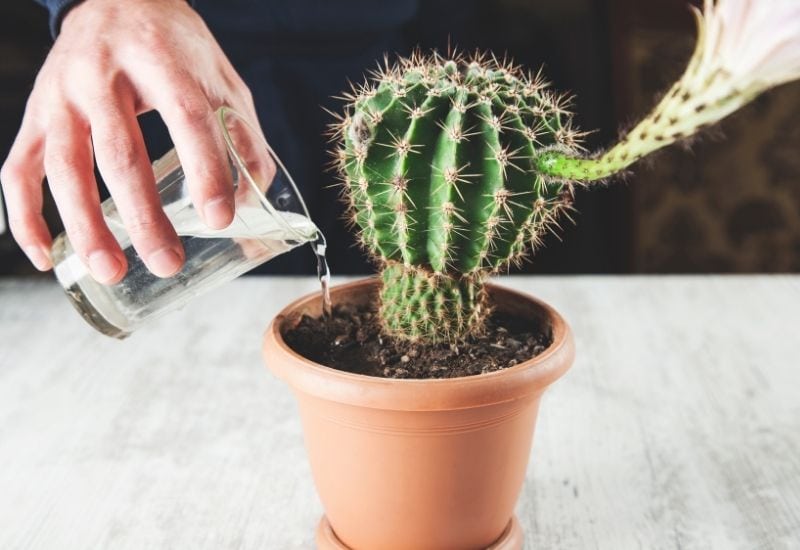
With these beautiful but peculiar plants, it is not just important to know when to water them, but also how to water cactus plants indoors.
In fact, there are a few important things for you to know about it.
This means that they can compensate more easily for excessive watering. Secondly, it allows it to absorb water more efficiently, because when the stomata are open.
This happens because every molecule that escapes from a stoma as vapor attracts a liquid one towards itself, forming like a little chain that goes all the way down to the roots. These, then use this process to absorb water from the soil…
Why do cacti need little water?

We all know that succulents in general need little water, and cacti are possibly the most iconic succulents of all.
They are very distinct from other plants because they are perfectly suited to live in dry places, usually hot, semi-deserts or very arid regions, like Arizona or Mexico, which have become synonymous with these plants.
Unlike other plants, they have stems or pads (like in Opuntia, a.k.a. prickly pear), or again, in other succulents, even leaves, that are, as you well know, thick and juicy.
This means that the surface of the stem or pad (or leaf), the epidermis is small compared to the volume. This means that they do not perspire as much water as other plants.
They also have fewer stomata (the pores on the leaves) than other plants, and this too, helps them withhold water within their bodies.
This explains why cacti and other succulents need very little water compared with other plants and also why they can go for long times without it.
Cacti drink slowly

But cacti and succulents are not just “special” because of their physiognomy, their shape and structure; also their metabolism is a bit unusual. If you water most plants, it will absorb it fairly quickly.
Depending on the species, water can travel from the roots to the leaves even in a matter of half an hour…
Now, ready to be surprised? How long do you think it will take a cactus?
About one week! Yes, it takes that long to move the water from its tiny roots to the end of its body, even if it is small.
All succulents have, in fact, small and shallow roots also because they need to absorb very little water indeed.
The dangers of overwatering Your Cactus
Never – absolutely never – be tempted to overwater your cactus. As a rule of thumb, it’s far, far better if you underwater it and let it even suffer thirst than if you give it too much water.
In fact, overwatering is arguably the biggest cause of cactus death with amateurs. So, avoiding it is not just advisable, but necessary.
For the very fact that they have a small surface compared with the volume and few stomata, overwatering, in fact, can spell disaster with cacti and very often death.
Why?
The water ends up packed into the stems or pads and the cactus just does not have enough “exits” (stomata) to get rid of it.
The water then produces pressure within the epidermis (the “skin” of plants) and causes the cells of the meristem (the “pulp” inside, or, to be technical, the tissue of non-differentiated cells within leaves and stems) to burst.
And this will certainly cause serious problems with your plant and it very often, by the time you notice it, it will be too late to save your plant.
Overwatering And Root Rot
Root rot is the most common cause of cactus death and it, too, is due to overwatering. Cacti have small and tender roots; they are not as developed as other plants’ and they can easily rot.
When your plant is in soil that is too moist, the roots will start to rot and pathogens will set in. They will turn brown and lose their natural shape and texture.
This can then even spread to the base of the stem and this is when most people find out that the plant is in serious trouble.
If you notice root rot at this stage, when you see some yellowing (or worse browning) and usually softening at the base of your cactus, then your only chance is to take a cutting of the healthy part of the plant, sprinkle it with organic sulphur powder, let it rest for at least 24 hours and then replant it.
In case you suspect your cactus has root rot, do not be afraid to take it out of the pot, cut off all rotting roots and even parts of the stem, again put sulphur powder on it, let it rest and then replant it. Succulents in general can stay out of the soil quite safely for a few days.
Overwatering, Pests And Molds
A humid soil or even atmosphere can also cause pest infestations and molds with cacti and other succulents.
These are usually much less serious than root rot or the effects of overwatering on the aerial part if your plant.
Still, even if you notice these (fungi often appear as slowly spreading gray, brown or white patches, or even lacerations on the stems, branches and pads), apart from using natural fungicides (like neem oil), you will need to reduce watering as well, suspending it at first altogether, and then only starting again once the soil has dried completely.
Signs that you have overwatered your cactus
How can you find out that you have overwatered your plant? Here are some clear symptoms:
Of course, this may end end up involving the whole plant, in which case, it will very likely be too late to save it.
In any of these cases, however, it is always better to remove the affected part of the cactus; once the meristem has lost its texture, there is no way it can recover, and, if you leave it, the problem may, and very likely will, spread further.
What should you do if you have overwatered your cactus?
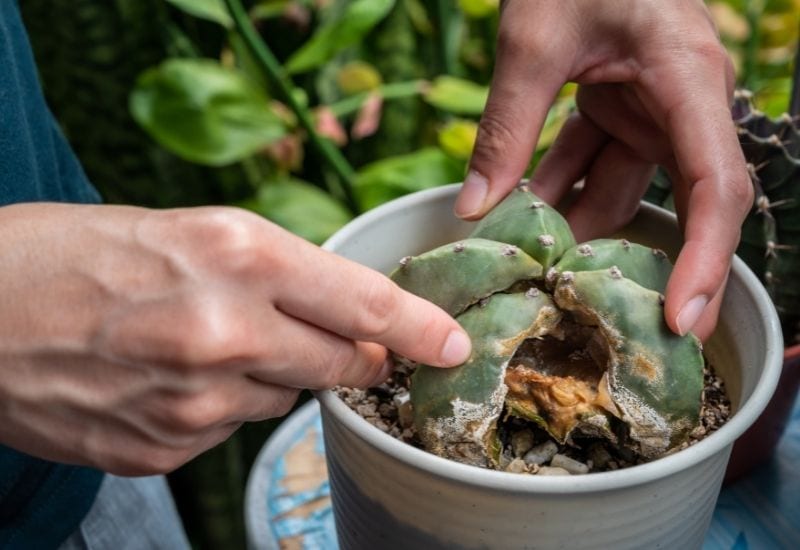
If you have overwatered a cactus, the remedy you will need will depend on the gravity of the situation.
If the plant is really sick, and you notice some signs of yellowing, softening of the tissue, then it will not be enough to suspend watering and reduce it in case:
In case you notice any rotting, then…
Your action will need to be commensurate with the damage the plant has received. In very extreme cases, you may only be able to save a small portion of your cactus.
Do not be tempted, though, to save any part of the plant that shows any symptoms of serious overwatering (mushy texture, browning, rotting etc.)
Underwatering cacti – is it a problem?
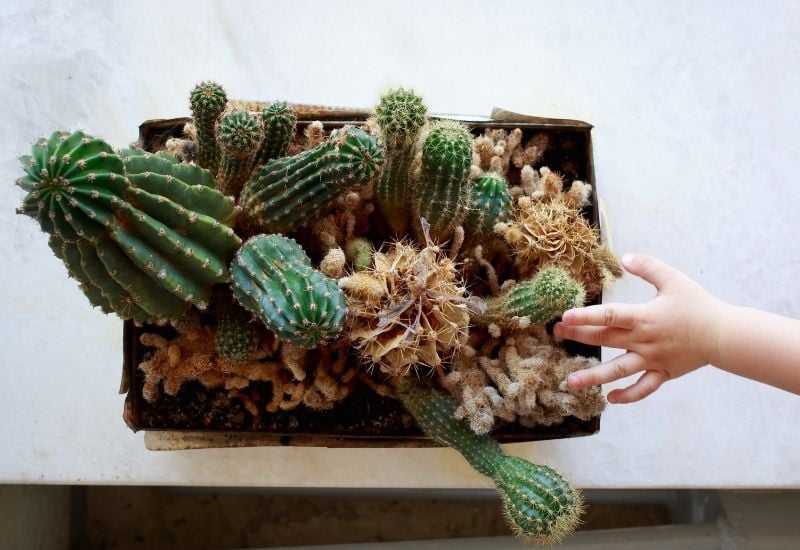
Of course, the idea is to give cacti the right amount of water at the right time.
However, Underwatering is, in my experience, a very common mistake with cacti and succulents.
Maybe because we know that they like dry places and can survive even long periods of draught, many of us tend to forget to water them as often as we should…
Still, thankfully, underwatering is far less dangerous than overwatering. In fact, if you underwater your cactus it will easily survive for a few weeks and, in some cases even months.
These plants are capable of preserving live tissue in periods of even severe draught.
Unlike with overwatering, where the plant finds it hard to contain the damage, cacti can “seal off” or isolate (depending on whether they have pads, branches or if the are a single stem) the dry area and preserve living tissue intact.
What is more, larger cacti can withstand overwatering for longer periods than small and young ones, this is simply because they have more volume to store water, and these incredible plants often need only a very small section of their bodies still with water inside to survive.
To find out whether you have unwatered your cactus, loom out for these symptoms, which are roughly ordered from the most serious to the earliest stage of underwatering:
The last symptom will be very common; but that should not worry you too much as you can simply start watering it again.
What can you do if you have under watered your cactus?

We have already seen the easiest solution, which is to start watering it again, however, when doing this, you should:
This should normally do the trick, unless…
Cactus water therapy
Now you will think I have gone mad, but near with me and I will explain why you can actually use water therapy with cacti…
In case you have literally forgotten your cactus for weeks or even months (maybe you went on holiday and it was left forgotten all the time you were away), and you notice that your cactus has severe signs of underwatering, for example that most of it or great part of it has gone dry or / and that it has lost most of its volume…
Then you need to check the roots:
If this is the case, then you should use water therapy with your plant. This basically means leaving the roots of your cactus in water for a couple of days…
But don’t worry, although it may seem crazy, fresh water does not have many bacteria like the water in soil, and this operation is actually quite safe.
Your cactus will start growing new roots and it will also perk up. This is what we call water therapy, and it is becoming fairly common with cacti and succulent gardeners and growers all over the world.
Cacti and water
As you can see, cacti have a very unusual relationship with water. They are very strong plants when it comes to draught and heat, but where water is concerned, less is better.
While the key rule, wait for the soil to dry fully before watering, is quite simple, it is easy to make mistakes both with excessive and too little watering. Fortunately, in most cases, you will be able to save your plant.
But I want to leave you with a final tip: learn to know your cactus, observe it, watch it and try to understand its “body language”.
Far too often do we take these plants as “objects” to put on a shelf and forget about them… This may be because they grow slowly, and because they get by even if we forget them…
But if you really want your cactus to be happy and healthy, every time you look at don’t do it only as “a work of art”, a “decoration”…
Remember it is alive and it too, in its own way, has needs, very few indeed, but still needs – like all living creatures…

Written By
Amber Noyes
Amber Noyes was born and raised in a suburban California town, San Mateo. She holds a master’s degree in horticulture from the University of California as well as a BS in Biology from the University of San Francisco. With experience working on an organic farm, water conservation research, farmers’ markets, and plant nursery, she understands what makes plants thrive and how we can better understand the connection between microclimate and plant health. When she’s not on the land, Amber loves informing people of new ideas/things related to gardening, especially organic gardening, houseplants, and growing plants in a small space.

I found your tips on caring, rescuing succulents and cacti very informative and helpful. Unfortunately it was after I started the rescue effort. I hope I didn’t kill my plants. The plants had a bad case of mealy bugs which I sprayed lightly with 70% alcohol per suggestion on several other sites. So far the bugs are gone. Re-potted all.